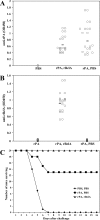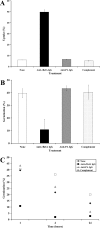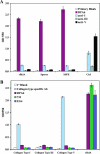Recombinant exosporium protein BclA of Bacillus anthracis is effective as a booster for mice primed with suboptimal amounts of protective antigen
- PMID: 17785478
- PMCID: PMC2168312
- DOI: 10.1128/IAI.00884-07
Recombinant exosporium protein BclA of Bacillus anthracis is effective as a booster for mice primed with suboptimal amounts of protective antigen
Abstract
Bacillus collagen-like protein of anthracis (BclA) is an immunodominant glycoprotein located on the exosporium of Bacillus anthracis. We hypothesized that antibodies to this spore surface antigen are largely responsible for the augmented immunity to anthrax that has been reported for animals vaccinated with inactivated spores and protective antigen (PA) compared to vaccination with PA alone. To test this theory, we first evaluated the capacity of recombinant, histidine-tagged, nonglycosylated BclA (rBclA) given with adjuvant to protect A/J mice against 10 times the 50% lethal dose of Sterne strain spores introduced subcutaneously. Although the animals elicited anti-rBclA antibodies and showed a slight but statistically significant prolongation in the mean time to death (MTD), none of the mice survived. Similarly, rabbit anti-rBclA immunoglobulin G (IgG) administered intraperitoneally to mice before spore inoculation increased the MTD statistically significantly but afforded protection to only 1 of 10 animals. However, all mice that received suboptimal amounts of recombinant PA and that then received rBclA 2 weeks later survived spore challenge. Additionally, anti-rBclA IgG, compared to anti-PA IgG, promoted a sevenfold-greater uptake of opsonized spores by mouse macrophages and markedly decreased intramacrophage spore germination. Since BclA has some sequence similarity to human collagen, we also tested the extent of binding of anti-rBclA antibodies to human collagen types I, III, and V and found no discernible cross-reactivity. Taken together, these results support the concept of rBclA as being a safe and effective boost for a PA-primed individual against anthrax and further suggest that such rBclA-enhanced protection occurs by the induction of spore-opsonizing and germination-inhibiting antibodies.
Figures





Similar articles
-
Recombinant Bacillus anthracis spore proteins enhance protection of mice primed with suboptimal amounts of protective antigen.Vaccine. 2008 Sep 8;26(38):4927-39. doi: 10.1016/j.vaccine.2008.07.015. Epub 2008 Jul 25. Vaccine. 2008. PMID: 18657585 Free PMC article.
-
Comparative analysis of the immunologic response induced by the Sterne 34F2 live spore Bacillus anthracis vaccine in a ruminant model.Vet Immunol Immunopathol. 2016 Oct 1;178:14-21. doi: 10.1016/j.vetimm.2016.06.005. Epub 2016 Jun 16. Vet Immunol Immunopathol. 2016. PMID: 27496738
-
The role of antibodies to Bacillus anthracis and anthrax toxin components in inhibiting the early stages of infection by anthrax spores.Microbiology (Reading). 2001 Jun;147(Pt 6):1677-1685. doi: 10.1099/00221287-147-6-1677. Microbiology (Reading). 2001. PMID: 11390699
-
Anthrax Toxins in Context of Bacillus anthracis Spores and Spore Germination.Toxins (Basel). 2015 Aug 17;7(8):3167-78. doi: 10.3390/toxins7083167. Toxins (Basel). 2015. PMID: 26287244 Free PMC article. Review.
-
Anthrax vaccines.Curr Top Microbiol Immunol. 2002;271:33-60. doi: 10.1007/978-3-662-05767-4_3. Curr Top Microbiol Immunol. 2002. PMID: 12224523 Review.
Cited by
-
A putative exosporium lipoprotein GBAA0190 of Bacillus anthracis as a potential anthrax vaccine candidate.BMC Immunol. 2021 Mar 21;22(1):20. doi: 10.1186/s12865-021-00414-y. BMC Immunol. 2021. PMID: 33743606 Free PMC article.
-
Immunogenicity of anthrax recombinant peptides and killed spores in goats and protective efficacy of immune sera in A/J mouse model.Sci Rep. 2018 Nov 16;8(1):16937. doi: 10.1038/s41598-018-35382-8. Sci Rep. 2018. PMID: 30446695 Free PMC article.
-
Characterization of a multi-component anthrax vaccine designed to target the initial stages of infection as well as toxaemia.J Med Microbiol. 2012 Oct;61(Pt 10):1380-1392. doi: 10.1099/jmm.0.045393-0. Epub 2012 Jul 5. J Med Microbiol. 2012. PMID: 22767539 Free PMC article.
-
Proteomic and genomic characterization of highly infectious Clostridium difficile 630 spores.J Bacteriol. 2009 Sep;191(17):5377-86. doi: 10.1128/JB.00597-09. Epub 2009 Jun 19. J Bacteriol. 2009. PMID: 19542279 Free PMC article.
-
Characterization of Bacillus anthracis Spore Proteins Using a Nanoscaffold Vaccine Platform.Front Immunol. 2020 Jun 23;11:1264. doi: 10.3389/fimmu.2020.01264. eCollection 2020. Front Immunol. 2020. PMID: 32714323 Free PMC article.
References
-
- Bozue, J. A., N. Parthasarathy, L. R. Phillips, C. K. Cote, P. F. Fellows, I. Mendelson, A. Shafferman, and A. M. Friedlander. 2005. Construction of a rhamnose mutation in Bacillus anthracis affects adherence to macrophages but not virulence in guinea pigs. Microb. Pathog. 38:1-12. - PubMed
Publication types
MeSH terms
Substances
Grants and funding
LinkOut - more resources
Full Text Sources
Other Literature Sources
Medical

